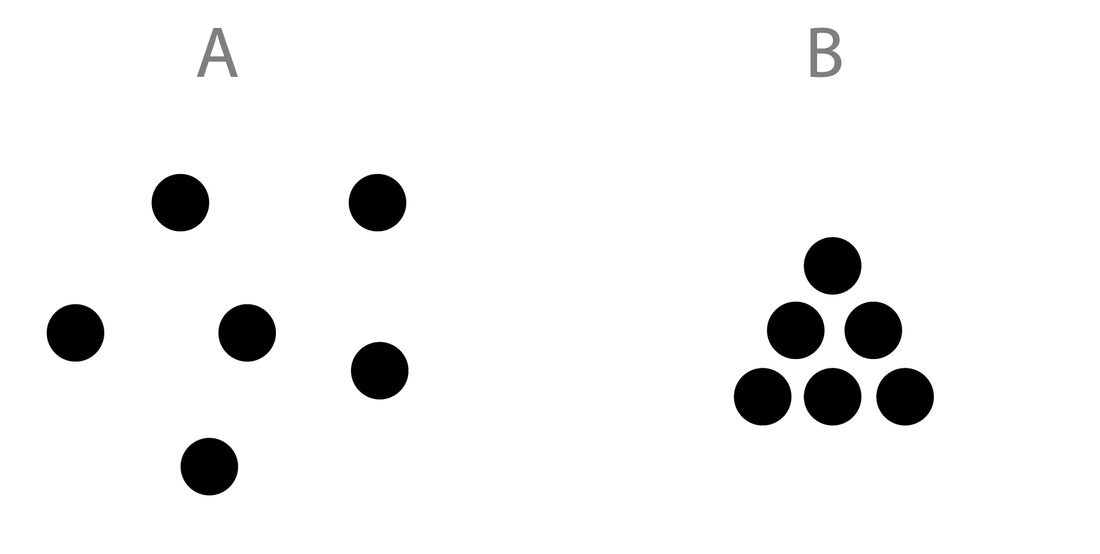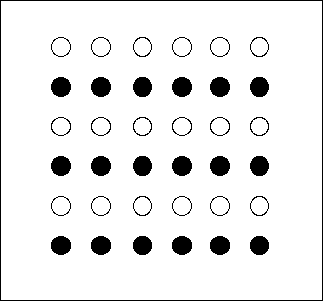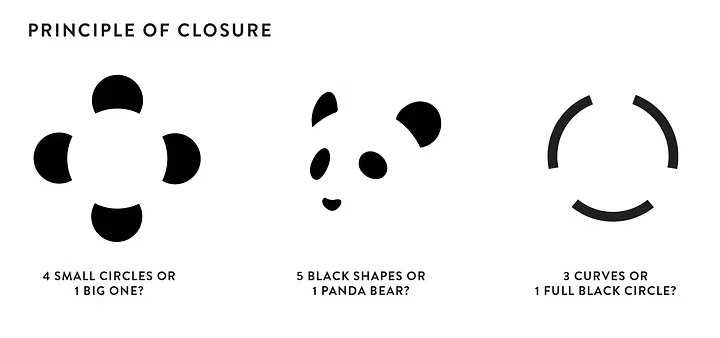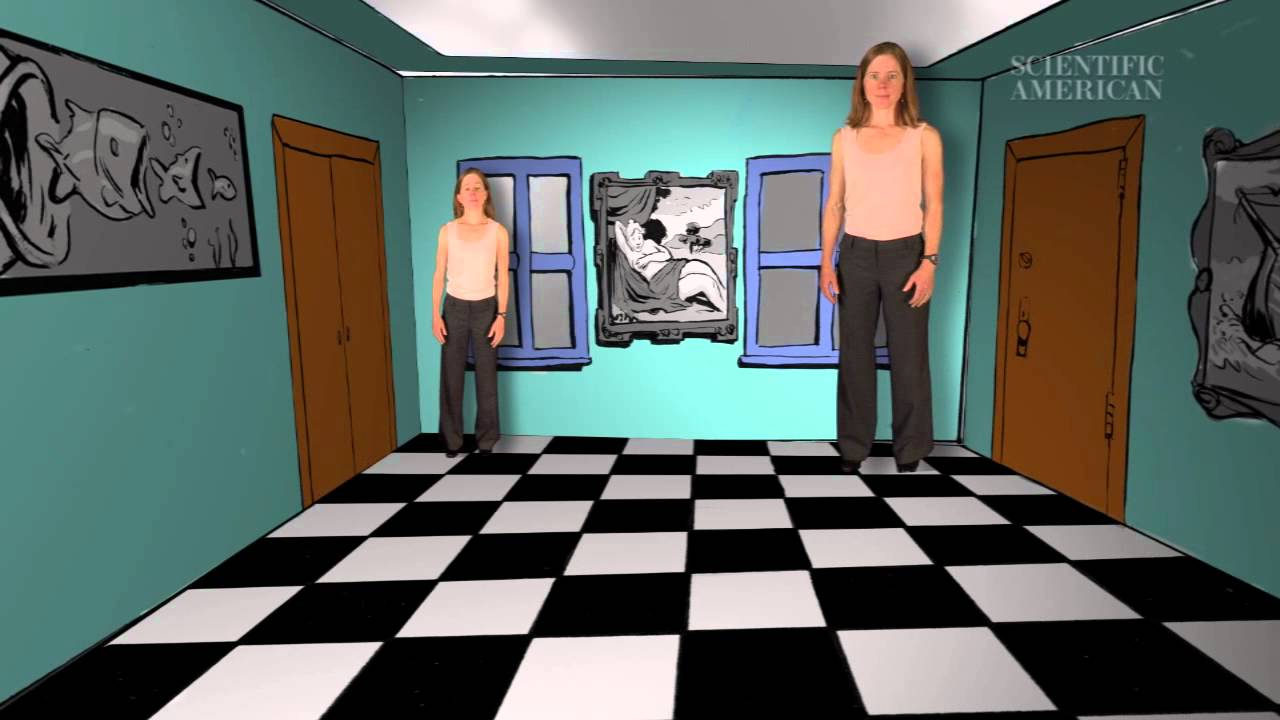Perception & Problem Solving
1/45
There's no tags or description
Looks like no tags are added yet.
Name | Mastery | Learn | Test | Matching | Spaced |
|---|
No study sessions yet.
46 Terms
Perception
Organization, identification, and interpretation of a sensation in order to form a mental representation
Bottom up processing
We notice what we “see” first
Sensory analysis starts at entry level
Ex: you see a shape with three connected lines, you look at angles, the edges and then the brain realizes that its a triangle.
Top down processing
We notice what we interpret first
constructing perceptions drawing both on sensations coming in and our experiences, expectations, and prior knowledge.
ex: you read a sentence with missing letters but can fill in the blanks based on your knowledge of language
Schemas ( an internal or external factor on perception? , definition? Example? )
Cognitive framework based on previous knowledge and experience that help us organize and interpret incoming information
more broad and long term than perceptual set
Blueprints of what things USUALLY look like or how situations USUALLY go
example: Walk into a restaurant and automatically expect menus and someone taking your order = restaurant schema
internal factor on our perception
Perceptual Set ( ( an internal or external factor on perception? , definition? Example? )
Mental predisposition that rely on familiar ways of perceiving stimuli; or the readiness to perceive a stimulus in a particular way
short term and more context dependent than schema
ex: You are told to look at a picture and also told that many people see a young woman first - because of that expectation you are more likely to see the young woman
ex: If you are looking at the clouds after watching a scary movie, you are more likely to interpret a shape as a monster rather than a harmless blob
Context ( an internal or external factor on perception? , definition? Example? )
guide perceptual interpretations ( typos pass unobserved )
personal experiences
cultural experiences and expectations
what we experience influences what we perceive and our assumptions about what we perceive
the sentence “its a bat” can be interpreted as a baseball bat if you’re in a sports store or a flying bat if you are outdoors.
Attention ( definition )
interaction of sensation and perception that is affected by internal and external processes
conscious awareness focuses on a very limited area of what you experience
AKA - you can only notice a certain amount of stimuli at one time ( selective attention )
Types of selective attention ( list and definition )
Cocktail party effect = Focus on one conversation in a noisy environment while still being able to notice important information from other noise : auditory cortex boosts some sounds to help the brain
Inattention blindness = miss stimuli in the environment since your attention is elsewhere in the moment [ NOTHING CHANGED, JUST DIDN’T NOTICE THE THING AT ALL ]
Change blindness = failing to notice changes in visual field / environment as a result of inattention [ MISS A CHANGE, NOT THE ENTIRE OBJECT ]
Types of perception ( list and definition )
Form perception = organize visual information into shapes and objects
ex: recognize a face from its features
about detecting shapes, patters, and objects
Depth perception = transform 2D into 3D and judge distance
ex: can tell that a car is far away even though it looks small in your visual field
uses cues like binocular disparity ( two eyes ) and monocular cues ( one eye )
always about distance, 3D space, near vs far
Motion perception = brain computes motion as images move across retina
ex: see a ball flying towards you and can tell what direction and how fast it is coming
Perceptual Constancy = being able to recognize an object no matter the angle, distance, or illumination
size constancy : a person walking away looks smaller but you know they are not shrinking
something changes in appearance but brain recognizes it as a constant
Form Perception : figure ground
Ability to separate an object from its background
ex: when reading you see black letters (figure) against a white page ( background )
ex: you either see two faces or a vase, but not both at once because one has to be the figure and other has to be the background
depends on what you focus on
Gestalt Organization Concept: Proximity
Grouping things that are close together

Gestalt Organization Concept: Similarity
Items that are the same or similar
ex: in the photo you see patterns

Gestalt Organization Concept: Continuity
Perceive continuous patterns ( despite any interruptions )
ex: you see two lines instead of four with interruptions and crossing between the two lines

Gestalt Organization Concept: Connectedness ( AKA Common Fate )
When things are seemingly connected or moving together are grouped together. Looks like a single unit.

Gestalt Organization Concept: Closure
we fill in gaps to see complete whole objects

Seeing objects in __ allows us to estimate distance
3D
Retina sees ___ images - __ takes those images and organizes it into 3 dimensions
Retina sees 2 dimensional images - the brain takes those images and organizes it into three dimensions
Binocular Cues ( definition, retinal disparity, convergence )
two eyes
Retinal disparity = the difference between the retinal images of our 2 eyes provides information about depth
ex: the closer the object the larger the disparity ( difference in image )
Convergence = a cue to nearby objects’ distance enabled by the merging of retinal images by the brain
Monocular Cues ( definition )
aspects of a scene that yield information about depth when viewed with only one eye
rely on the relationship between distance and eye
can give the illusion of depth on flat or 2 d surfaces
Types of monocular cues ( list and definition )
Texture gradient = textures are more clear up front
Relative size= objects that are close appear bigger
relative height = objects closer are lower in our field of vision and those farther away appear higher
interposition = when one object blocks another the one in front is perceived as closer
Linear perspective = parallel lines seem to converge in the distance ( ex: railroad tracks )
light and shadow = closer objects appear brighter ; shading produces depth
relative clarity = hazy objects perceived as distant
Motion perception
objects traveling toward us growing in size and those moving away shrink in size
Motion Parallax
Objects closer move past faster than objects farther away
( viewing the scenery from a moving car, a far mountain vs the roadside )
Stroboscopic Movement
Brain sees rapid series of slightly different images as movement ( flip book )
Phi Phenomenon
Lights turning on and off in sequence we perceive as movement ( lane ending signal )
Perceptual constancy ( definition )
being able to recognize an object regardless of angle , distance, or illumination
list and define types of perceptual constancy
Shape = shape is constant even if the retinal image changes
color = we perceive familiar objects has having consistent color even if changing illumination
size = perceive certain objects to have an unchanging size, no matter how far away
Illusions
using perceptual constancy and other aspects of perception, images can be manufactured to create illusions, where you perceive one thing but in reality it is something different. This can be for perception types like size, depth
Ponzo illusion: an illusion of size in which 2 objects of equal size are positioned between two converging lines so they appear to be different sizes
Ames room = confuses assumptions of the horizontal and vertical natures of square rooms

Concepts
mental groups of similar items, people, places → forms the basis of thought
An AP Psychology concept example is classical conditioning, where a child associates a neutral stimulus (a dog) with an unconditioned stimulus (being bitten) to develop a conditioned response (fear).
Prototypes
the best/most typical example of any given concept
think of it at the first thing that comes to mind
helps for easy sorting by matching new items to prototypes ( AKA how does this best match the most typical example )
robin for the category "bird" or an apple for the category "fruit". This is because a robin and an apple are the best or most typical examples
Schemas
frameworks for thinking
patterns of thinking and behavior that people use to interpret the world
EX: a child learning about animals. For instance, a child might have a basic "dog" schema (four legs, furry) and then see a cat. They might initially try to fit the cat into their "dog" schema (assimilation). When they learn a cat is a different animal with unique traits like meowing and a different "dog" schema, the child modifies their existing understanding and creates a new "cat" schema (accommodation)
Assimilation
improving existing knowledge of something thanks to new but congruent information NOT CHANGING THE SCHEMA
ex: a child believes that a dog is furry, but they later learn that dogs have four legs
Accomodation
taking in new information and changing the existing schema to incorporate the new information that contradicts previous thinking when a child who believes all four-legged animals are "dogs" encounters a cat, realizes it's not a dog, and must create a new "cat" schema to incorporate this new information.
Problem solving : Algorithm
Step by step procedures or set of rules
addresses problems by attempting all possible solutions until correct one is found
Problem Solving : Heuristics
Reduce number of options with “mental shortcuts” to make judgements; experience-based strategy but doesn’t guarantee a correct outcome
Examples include crossing the street by first looking both ways, which uses a quick assessment of danger instead of a lengthy risk analysis, or using the availability heuristic by assuming a plane crash is more likely after seeing it in the news.
Problem Solving: Insight
“Aha!” moment
the solution just comes to us
Creativity
coming up with new or novel ideas and engaging in divergent thinking ( instead of convergent )
Convergent thinking vs divergent thinking
Convergent = looking for the “right “ answer [ what is expected, used to ]
Divergent = looking for a unique/creative answer [ looking at different approaches ]
Executive functions
cognitive processes that allow individuals to generate , organize,plan, and carry out goal directed behaviors and experience critical thinking
frontal lobes
Representativeness Heuristics
judge the likelihood of things based on if they fit a prototype (using stereotypes ) or prior expectations
Allows you to make snap judment
ex: assuming a quiet, analytical person who wears glasses is an accountant rather than a salesperson
Availability Heuristics
Estimate probability of an event based on how easily the information pops in our mind
recalling the first or most vivid example that comes to mind
ex: overestimating the risk of a plane crash after hearing about it on the news, but underestimating car crashes which are more deadly and frequent
Belief Perseverance
We cling to our beliefs even if evidence proves them wrong.
Mental Set
prior experiences that were successful
Leads to sticking to most familiar and ignoring alternatives
Functional Fixedness
we only thinking of using an object for the intended use
ex: not being able to use newspapers to cover up an object
Priming
the activation , often unconsciously, of particular association in memory
where a person's reaction time or understanding of a word is faster if it's preceded by a related word. For instance, if you see the word "doctor," you will process the word "hospital" more quickly afterward because the concept has been activated in your mind. Another example is conceptual priming, where being primed with words related to "money" or "prestige" can influence a person's later decision, such as choosing more expensive socks
Gamblers Fallacy
the mistaken belief that past events can influence future events that are entirely independent of them in reality
ex: flipping heads on a coin 5 times in a row means that you will flip heads
Sunk cost fallacy
tendency to continue with an endeavor we’ve invested money, effort, or time into - even if current costs outweight the benefits